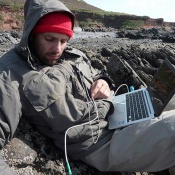MED-HIST: A slow motion perspective of the Biogeographic History of the Mediterranean Sea
The Mediterranean Sea harbors strongly marked and ancient signatures resulting from its troubled geological and climatic history, which can be perceived from patterns of population genetic differentiation to the heterogeneous distribution of its diverse biota [1]. Two events marked the history of the Mediterranean. One occurred in the Miocene, when the connection between this basin and the Atlantic was interrupted leading to the Messinian Salinity Crisis (MSC) and to the extinction of most of the paleo-fauna [2]. The other included the glacial-interglacial cycling in the Pleistocene [3]. However, the rich climatic/geological history of the Mediterranean, together with its unexpectedly high species’ diversity, has no parallel in the number of studies trying to match such events with geographic patterns of genetic differentiation. Species’ phylogeography has so far been investigated in organisms which have high dispersal capabilities, and mostly in the western basin of the Mediterranean. This bias may be hindering our knowledge about the evolutionary patterns within the Mediterranean Sea, since past and contemporary population connectivity may obscure the signs of historical events [4].\nWith the MED-HIST we expect to provide a much more comprehensive picture of the historical and contemporary processes driving the geographic and genetic distribution patterns in the Mediterranean basin. To do this, we will focus on a group of organisms, the isopod genus Stenosoma, which combines several species with interesting traits: 1) as all peracarids, they are direct brooders with no planktonic stage, depending exclusively on rafting to disperse; 2) most of the species occur in the Mediterranean, and while some range throughout the entire basin, others are restricted to relatively small regions; 3) some of these species extend their ranges into the adjacent waters of the Atlantic and the Black Sea.\nThe main goal of this project is to infer the history of diversification of the genus Stenosoma (Crustacea, Isopoda) in the whole Mediterranean basin. We will investigate if the species occurring in the Mediterranean derived from Atlantic species that have recolonized this basin after the MSC or if they had pre-Messinian Mediterranean ancestors. We will also inspect the extent of the effects of the Pleistocenic glacial events, which are known to have caused speciation by allopatric divergence in peracarid isopods [5]. Given the low dispersal ability of Stenosoma species, we expect that the signatures of such events will be well imprinted in their genetic patterns.\nA two-prong approach will be used to address the hypotheses formulated above: species’ phylogeography and a phylogeny of the genus. The phylogeographic analyses will allow us a) to investigate the effects of historical geological and climatic events on past population connectivity and on vicariance processes leading to differentiation in each species; b) to understand the role of key basin transitional areas (e.g. Atlantic-Mediterranean transition), as historical or contemporary barriers to dispersal; and c) to look for glacial refugia signatures and routes of colonization, having in mind that long range dispersal events through rafting may have occurred. Our results (unpub. data) suggest the existence of glacial ‘refugia within refugia’ [6] in Southern Iberia which, to be confirmed, will be the first described for the marine realm. The phylogenetic analysis will be used to set the chronology of species’ phylogeographic patterns allowing us to better understand the details of the genus evolution in the Mediterranean. Preliminary results on the phylogeny of the genus revealed that the mitochondrial genome of Stenosoma has gene inversions and different nucleotide compositions between species, which suggests that molecular evolution within the genus involved gene rearrangements. Therefore, we will adopt an innovative approach by using the whole mitochondrial genome for the phylogenetic analysis, which will improve significantly phylogenetic inferences [7]. MED-HIST will provide a completely new perspective on the role of the major geological/climatic events which occurred in the Mediterranean in shaping current patterns of genetic diversity of coastal marine organisms. Since this will be the first study to involve low-dispersal organisms within the whole Mediterranean basin, it will serve as a reference with which to compare results derived from species with different dispersal abilities. Data will also be extremely useful to estimate levels of cryptic species, or signs of cryptic speciation, known to be common in organisms with low dispersal capabilities. Furthermore, with these data we will address two phylogenetic aspects which have been recently debated: one concerns the implications of nucleotide biased composition on phylogenetic reconstructions [8] and the other consists in investigating the usefulness of gene rearrangements to clarify arthropod phylogeny [9].



